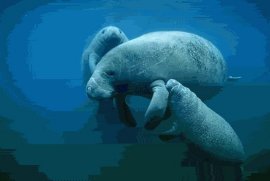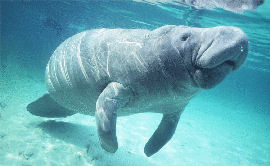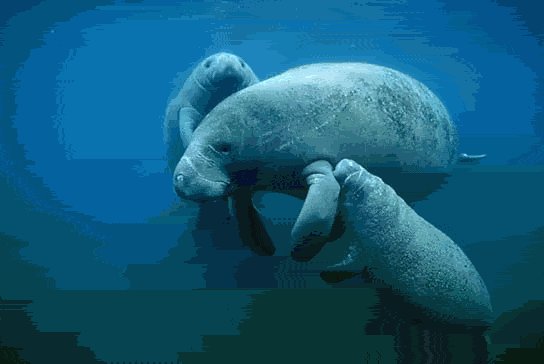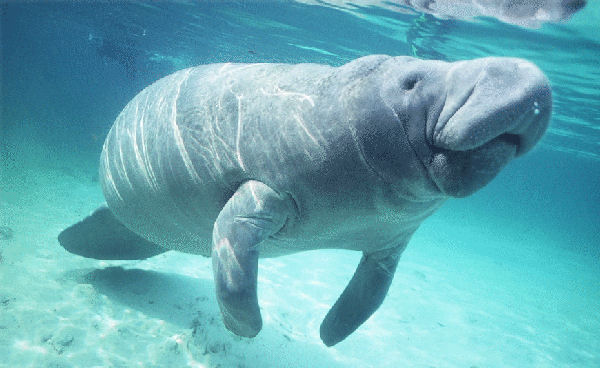Marine Mammals
Description
Massive, torpedo-shaped, nearly hairless aquatic mammal. Grayish to blackish when wet. Tail broad, flattened, paddle- shaped. Broad head with upper lip deeply cleft and bearing stiff bristles. Front legs like large flippers, with 3 nails at end; hindlegs absent. No external ears. L 9' 10"–11' 6" (3–3.5 m), maximum about 13' (4 m); Wt 1,100 lb (500 kg), maximum about 3,500 lb (1,600 kg).
Endangered Status
- The Manatee is on the U.S. Endangered Species List. It is classified as endangered throughout its range in the U.S. (Alabama, Florida, Georgia, Louisiana, Mississippi, North Carolina, South Carolina, and Texas). Hunting Manatees is now prohibited in the U.S., but for many years here the Manatee was hunted for its meat and oils, and it is still heavily hunted in Mexico and Central America. Population growth and unabated tourism have meant inadvertent damage to the Manatee. Its habitat has been altered by development, and too much human activity may drive Manatees away from areas of good browse. This large animal is slow and incautious, and many individuals are injured or killed by boat propellers (in some Manatee habitats, boating is now prohibited or speeds regulated). Other dangers include the release of warm water from power plants, which may lure the animal to areas of insufficient browse, and canal lock systems, which limit access to Manatee habitat.
Range
Gulf and Atlantic coastal waters of se U.S. north to Beaufort, North Carolina. Florida’s waters have largest remaining populations. Mainly a summer migrant north of Florida.
Discussion
The Manatee is a primarily nocturnal and moderately social animal that congregates in warm water in winter. It can swim quite rapidly for a short distance, but its normal cruising speed is only 1 1/2 to 4 mph (2.4–6.4 km/h). Propelling itself with undulations of the hind end of its streamlined body, the Manatee uses its flippers and tail mainly for steering and stabilization. When at rest, the animal either hangs in the water, partially supporting itself on submerged vegetation, or lies on the bottom. It can remain submerged for up to 24 minutes, but about four minutes is the normal length of submergence. The Manatee browses on aquatic vegetation, particularly water hyacinth and hydrilla, but also on a number of other species, which it grasps in its lips and bristles, using its flippers to hold loose grass blades. An adult consumes 60 to 100 pounds (27–45 kg) of food per day. The Manatee sometimes swims far up on the beach to get plants on shore, and at times may even eat acorns. In Florida, the Manatee performs a valuable service by consuming quantities of water hyacinth, which chokes many waterways. The sounds the Manatee produces include squeals, chirp-squeaks, and a high-pitched scream when frightened; the female gives an alarm call to her young. Several males may be attracted to a female in estrus, and she may mate with several of them. Born underwater, the young Manatee is immediately brought to the surface on its mother’s back; after about 45 minutes, it is gradually immersed again. Nursing takes place underwater and may continue for one to two years. Manatees cannot survive water colder than 46°F (8°C) and in winter move upriver to warm lakes or to the heated discharge from power plants. Large sharks, alligators, crocodiles, and killer whales are possible predators, at least on the young.




